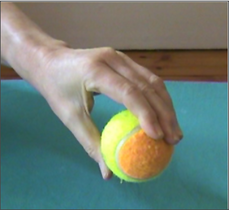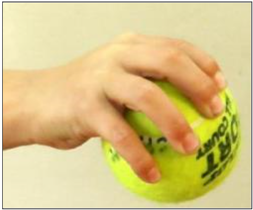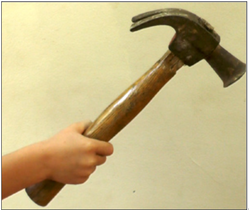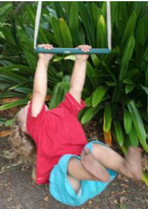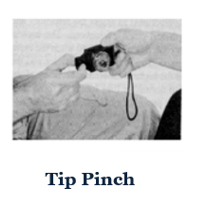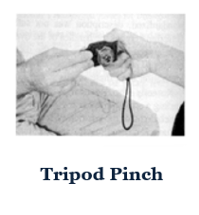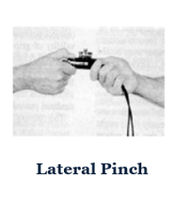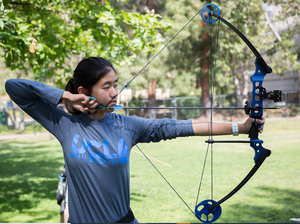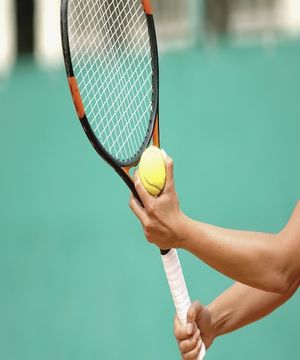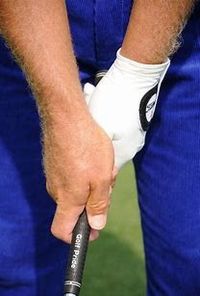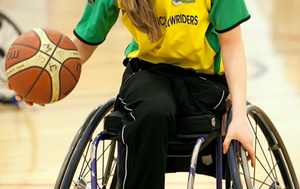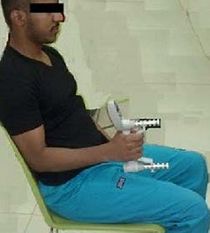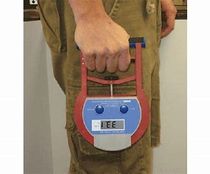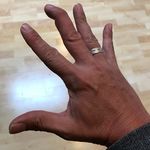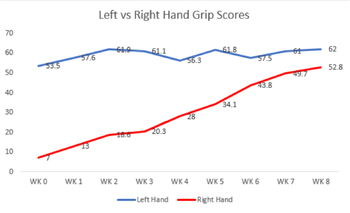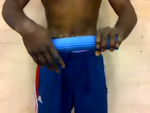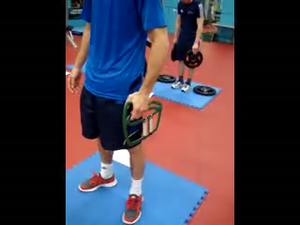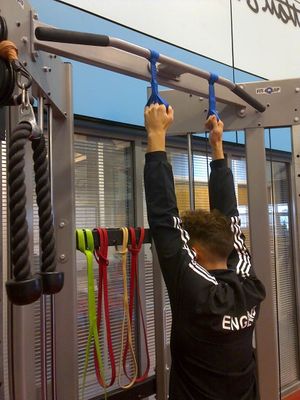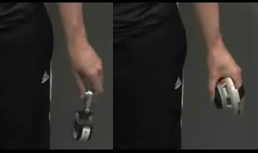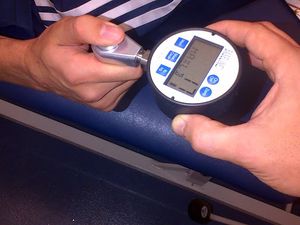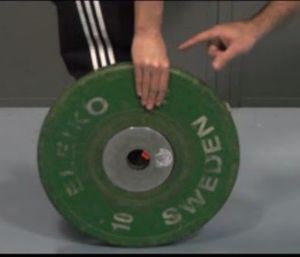Sporting Hand and Wrist - Why Power and Pinch Grips Matter
Types of Grip[edit | edit source]
The hand anatomy is efficiently organized to carry out a variety of complex tasks combining intricate movements and finely controlled force production. The soft tissue structure of the hand is complicated and any injury to any of these even very small structures can alter the overall function of the hand and thereby complicate the therapeutic management[1]. Hand function and strength are important elements in day to day life and participation in sports [2].
Gripping or the ability to fold the fingers into the palms supported by the thenar and hypothenar eminences to make a club-like structure is exclusive to humans[3].
The grip function of the hand is of great importance in professional and daily life activities. These activities are produced by combining different types of grips[1]. Types of Grip[4]:
1-Power Grip: closing a hand with the thumb in opposition to all other fingers together generates a power grip[5].
A-Lumbrical grip
B-Spherical grip
C-Hammer grip
D-Hook grip
| Lumbrical grip | Spherical grip | Hammer grip | Hook grip |
|---|
2-Pinch grip: the holding of an object between the thumb and fingers of a single hand.
A-Tip Pinch: index pressing against the thumb: holding an object between thumb and a fingertip is used for fine manipulation[1].
B-Tripod Pinch (Chuck pinch): increases the stability by utilizing two fingertips instead of one.
C-Lateral Pinch, also known as key pinch[5]: achieved by pressing the thumb pulp against the lateral aspect of the proximal interphalangeal joint of the index finger. In this grip, the thumb is going into adduction and flexion[5].
The peak forces generated with the three-digits and lateral pinch grips are about 40% greater than that produced with the tip pinch[1]
Lateral pinch is the strongest type of pinch followed by tripod pinch. Tip pinch is used for more sophisticated processes requiring fine coordination.
| Tip Pinch | Tripod Pinch | Lateral Pinch |
|---|
Grip Strength in Day to Day Life[edit | edit source]
Daily activities require a combination of different movements in the upper limb. Hand function is an important component of these movements. The loss of grip strength is associated with a number of pathologies. Hand Osteoarthritis is a is a common chronic condition involving one or more joints of the thumb and fingers. It is associated with pain, reduced grip strength, loss of range of motion (ROM), and joint stiffness leading to impaired hand function and difficulty with daily activities [6]. Stroke is another condition that impacts the upper limb and hand function. Addressing these conditions requires an understanding of the hand anatomy and biomechanics.
There are numerous factors such as sex, age, and hand preferencethat contribute to the grip strength and they should be considered when making clinical decisions. The average grip strength of women is approximately 60% that of men, and for both sexes, grip strength reaches a maximum during the fourth decade of life and declined thereafter with increasing age[1].
Cold weather causes reduced muscle contraction and affects grip strength and function of the hand[1].
It is believed that the difference between the dominant and non-dominant hand in strength is 10% (known as the 10% rule). This applies to right-handed people. For left-handed persons, grip strength is considered equivalent in both hands[1].
The hand strength in daily activities is classified into three main functional groups[7]:
- Activities are requiring force and rotation (e.g., unscrewing the jar lid)
- Activities are requiring dexterity and precision (e.g., peeling fruits)
- Dynamic activities, primarily based on pinching and performed with the first two or three fingers of the dominant hand (e.g., writing with a pencil)
Grip in Sports[edit | edit source]
The combination of grips differs according to the type of sports and hand dominance. If you are involved in sports rehabilitation, understanding the type of grip and involvement of the thumb is important to measure the strength and address any related injuries[5].
Here are some examples of different grips used in various sports[5]:
| Sport | Grip | Illustration |
|---|---|---|
| Bow and arrow | The lead hand holding the bow and keeping it stable in a power grip. Whereas the backhand, pulling the string, also in power grip but the thumb is less involved going into more adduction. | |
| Racquet sports such as tennis: | Hand holding the racket using a power grip and the other hand holding the ball in a pinch grip. By changing the grip, the movement and the force changes. | |
| Golf: | Lateral pinch or key grip is used but that could change during the game depending on the movement and how much strength is required. | |
| Wheelchair sports, for example, basketball | The hand holding the wheelchair would require more strength from the thumb for stability. the other hand holding the ball would use a spherical grip in which there will be cupping at the wrist and adduction at the thumb. | |
| Weight lifting | The use of a hook grip is recommended in weightlifting movements[8] | |
| Boxing: | Power grip is used. Injury at the base of the CMC joints of the index and middle fingers is common causing instability and interferes with the gripping power[5]. |
Measuring Grip Strength[edit | edit source]
Measuring grip strength is commonly used in research and sports to measure the efficacy of an intervention. It is a useful practice to implement in hand rehabilitation that would help on decision making and reporting outcomes.
Dynamometers[2]: the Jamar and the Takei are the most common studied dynamometers in the literature.
The Jamar dynamometer is considered to be the gold standard for documenting manual grip strength. It is comprised of:
- an adjustable anatomical rigid handle
- hydraulic system
- analogue display
The Takei is a valid and reliable tool to measure power grip. It is comprised of:
- Adjustable rectified
- Complacent handle shape
- Electromechanical system
- A digital or analogue display
Important points to consider when testing grip strength[5]:
- Note the associated symptoms such as pain or instability. The timing of the symptoms also matters whether they accompany the movement or start after the testing.
- The difference between the right and left hands. Consider the element of chronicity could lead to weakness due to reciprocal inhibition.
- Repeat the test for 3 times starting with the non-painful side then move on to the other hand and alternate the testing between hands for three times
- Look for the peak force (the best number that could be achieved on testing). Some people might be able to generate a high number on the strength test but then the number lowers due to fatigue or they take few repetitions to generate the force
- Testing position:
- Elbow in a 90-degree angle: helps to generate the highest peak. However, having the forearm in mid-position could lead to contraction of the brachioradialis muscle and the movement will not be generated purely from the hand.
- Testing from straight elbow position and wrist in neutral. This position is recommended by Gatt I.[5] to isolate hand muscles.
Injuries and Grip Strength[edit | edit source]
A study by Loosemore et al[3] explored hand and wrist injuries in both training and competitions in boxing found:
- Boxer's Knuckles (Finger carpometacarpal instability and finger metacarpophalangeal joint extensor hood and capsule sprain) to be the most common injury.
- The incidence of training injuries was similar to that of competition injuries.
The study also measured the grip strength in both hands at baseline and after injuries and concluded:
A difference of 15% between both hands is considered normal
Boxers who had a difference of 20% are likely to have an injury. Higher than 20% places the athlete at a higher risk for pathologies.
Following an injury, an 87% difference in bilateral hand gripping strength was observed in the same study.
Injuries affecting Grip strength:
Pulley ruptures
Traumatic Extensor Hood Rupture
Extensor Tendon Injuries of the Fingers and Hand
Triangular fibrocartilage complex tears
Rehabilitation of Grip[edit | edit source]
Hand grip measuring should be a key component during the rehabilitation process to measure the effectiveness.
Power Grip:
A case study of a boxing injury: Handgrip strength was tripled in three weeks of conservative management[5] and the difference dropped from 87% to 15% on testing between right and left hands
Functional rehabilitation is recommended. Monitoring symptoms and progression into function training and power grip training.
Isokinetic training machine:
Expensive but a useful kinetic machine
Can be used to measure the flexor/extensor muscle strength both eccentrically and concentrically with speed variations. The same measures could be adjusted for rehabilitation.
Other equipment:
rubber tools also known as flex bars. Can be used in different forms to target the wrist and forearm muscles. Also can be used for different purposes, strength and conditioning. The Intensity is linked with the number of repetitions but you can advice different colours for different strengths.
Crushes: is another tool that could be used to improve the power grip. The spring can change the strength.
Talon grips: designed ergonomically to adapt to the shape of the hand to give uniform loading on the tendons, can be used with pull-ups.
The width of the grip used by the athlete is a factor to be considered such as in rugby or Javalin and putters and the amount of time the athlete is gripping.
Pinch Grip:
There are two different types of dynamometers.
Pinch grip dynamometer or handheld dynamometer: there are two positions to hold and exercise from.
key grip: useful to strengthen the flexors and places the joint in a closed position. Involves the thumb more than the pinch grip.
The use of which grip or position depends on the onset and severity of injury.
.
A plate can be used to strengthen the grip: there are different variations depending on which muscles to involve. The time to hold can be adjusted on the type of training and also could be used to check the maximum hold between right and left hands.
Monitoring the symptoms associated withholding such as pain, time of occurrence and effect on holding can be useful data int eh management.
Putty: can help with a pinch grip using different variations
Flipping Plates: good exercise to improve thumb and wrist proprioception.
References[edit | edit source]
- ↑ 1.0 1.1 1.2 1.3 1.4 1.5 1.6 Duruoz MT. Hand function. Springer-Verlag New York; 2016.
- ↑ 2.0 2.1 Gatt I, Smith-Moore S, Steggles C, Loosemore M. The takei handheld dynamometer: an effective clinical outcome measure tool for hand and wrist function in boxing. HAND. 2018 May;13(3):319-24.
- ↑ 3.0 3.1 Loosemore M, Lightfoot J, Gatt I, Hayton M, Beardsley C. Hand and wrist injuries in elite boxing: a longitudinal prospective study (2005-2012) of the Great Britain Olympic Boxing Squad. Hand. 2017 Mar;12(2):181-7.
- ↑ Gatt I. Hand and wrist injuries: a focus on boxing. A Comprehensive Guide to Sports Physiology and Injury Management E-Book: An Interdisciplinary Approach. 2020 Nov 28:315.
- ↑ 5.0 5.1 5.2 5.3 5.4 5.5 5.6 5.7 5.8 Gatt I. Sporting Hand & Wrist - Why Power & Pinch Grips Matter. Physioplus Course 2020
- ↑ Magni NE, McNair PJ, Rice DA. The effects of resistance training on muscle strength, joint pain, and hand function in individuals with hand osteoarthritis: a systematic review and meta-analysis. Arthritis research & therapy. 2017 Dec 1;19(1):131.
- ↑ Duruöz MT, Poiraudeau S, Fermanian J, et al. Development and validation of a rheumatoid hand functional disability scale that assess functional handicap. J Rheumatol. 1996;23:1167–72.
- ↑ Oranchuk DJ, Drinkwater EJ, Lindsay RS, Helms ER, Harbour ET, Storey AG. Improvement of kinetic, kinematic, and qualitative performance variables of the power clean with the hook grip. International journal of sports physiology and performance. 2019 Mar 1;14(3):378-84.
- ↑ Pinch grip strength putty R. Available from:https://www.youtube.com/watch?v=QxaP5P9CSWc[last accessed 28/12/2020]
- ↑ Power grip strength putty R. Available from:https://www.youtube.com/watch?v=DufAYWGidsc[last accessed 28/12/2020]
- ↑ Plate Flip | Better Grip | Forearm Strength | Move and Perform Better. Available from:https://www.youtube.com/watch?v=Z-qNThP5Sjw[last accessed 28/12/2020]
